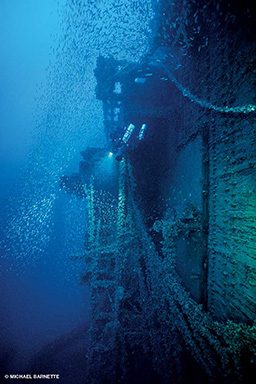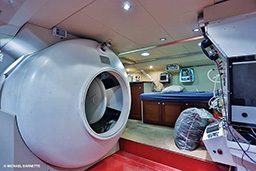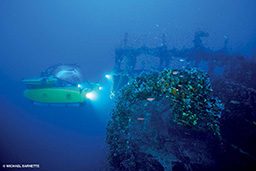For experienced technical divers, the Britannic is the quintessential wreck dive. This Olympic class ocean liner is the sister ship of perhaps the most famous vessel in history: RMS Titanic. Unlike the Titanic, Britannic never carried passengers on the transatlantic route. Instead, the British government employed it as a hospital ship with the outbreak of World War I. In the course of that service, it struck a mine deployed by the German submarine U-73 in the Aegean Sea on Nov. 21, 1916. HMHS Britannic now rests on its port side in approximately 400 feet of water, less than 3 nautical miles off the Greek island of Kea.
Simply put, the Britannic wreck is spectacular. Given its pedigree and the fact it rests tantalizingly close to shore, one might think technical divers visit the site regularly. But there are even greater hurdles to exploring the wreck than its depth. One must first acquire permission from the British owner of the wreck site as well as permits from the Greek government before even considering the sourcing of tanks, breathing gas and additional gear needed for diving operations. Planning usually takes several months or even a year. And all this is easier said than done. Having participated in a previous expedition to Britannic in 2006, I was well aware of all the bureaucratic and logistical issues that generally wreak havoc on planned diving objectives. It is for this reason I was a little taken aback when I received an invitation to dive this epic ocean liner from noted wreck diver Richie Kohler with advance notice of only one month.

Unbeknownst to me, underwater imaging expert Evan Kovacs had hounded the Malta-based, Russian-staffed exploration and filming company U-Group for more than a year in hopes of joining them in Greece. Affiliated with the Russian Geographical Society, U-Group had been exploring and filming Britannic using a three-man submersible and remotely operated vehicle (ROV) from their research vessel U-Boat Navigator for the past two years. Kovacs hoped to piggyback on their permit to conduct reconnaissance in advance of a much larger future expedition to Greece.
With the apparent support of U-Group and excitement about again visiting the wreck of Britannic, we found ourselves headed back to Kea in late June 2015. Accomplished Italian diver Edoardo Pavia — driving a van full of tanks, breathing gas, rebreather consumables and other necessary gear across Greece — rounded out our small team. But because of a general lack of interaction and communication between Western divers and our Russian counterparts, we were not exactly sure what to expect upon our arrival.
Fortunately, our initial meeting aboard U-Boat Navigator allayed any uncertainty we may have had about the crew or their capabilities. We were pleasantly stunned by all the tools on board the research vessel. Aside from the aforementioned submersible and ROV, they had a large chase boat, a multibeam and side-scan sonar, a massive fill station, an elevated dive platform, an amazing clinic with a multiplace hyperbaric chamber, a fully equipped video production station and a diving bell complete with communications, video, hot water and abundant supplies of emergency breathing gas. The diving bell would allow up to two divers at a time to stand up in an air-filled chamber, remove their gear and have a chat or get a drink of water, all while being monitored by a hyperbaric physician topside. With planned dive times approaching six hours, the diving bell radically increased safety compared with conventional open-water decompression while also offering a great diversion from the monotony of decompression stops.

The enhanced safety provided by the in-water monitoring and the diving bell had special significance in light of Carl Spencer’s fatal dive on May 24, 2009, while leading a National Geographic expedition to Britannic. Spencer was an extremely competent technical diver and was very familiar with Britannic; the 2009 project was his third expedition to Kea. He had also led or participated in numerous other technical diving expeditions, including a 2007 venture to the liner Carpathia, rescue ship to Titanic, which rests at approximately 500 feet about 200 nautical miles off the coast of Ireland. Yet he passed away on a dive that, at face value, should have been routine for someone with his experience. Unfortunately, he made a series of mistakes that culminated in him breathing from an improperly labeled cylinder, resulting in an in-water seizure from oxygen toxicity at approximately 120 feet. With no good options, support divers rushed Spencer to the surface in hopes of treating him in the expedition vessel’s hyperbaric chamber. Tragically, all efforts to save him were unsuccessful. During our initial inspection of U-Boat Navigator, we realized with heavy hearts that had Spencer been diving with the tools we now had at our disposal, his death perhaps could have been prevented.
About 24 hours after I landed in Greece I was suited up and ready to splash on the wreck of the French liner Burdigala to conduct a checkout of my gear. Meanwhile, our entire team was evaluating the operations of the U-Boat Navigator, while I suspect the Russian crew was ensuring we weren’t a bunch of crazy Americans (and one Italian) intent on killing ourselves. We successfully completed a shakedown dive on Burdigala, which rests at a little more than half the depth of Britannic, and interacted with the submersible and ROV at depth. On a second dive to the wreck, we included the diving bell in operations to test and familiarize ourselves with it prior to employing it on a much longer, deeper dive. Having established an efficient communication protocol with the topside crew and worked through potential scenarios for future dives, we were ready for Britannic.

Britannic, however, was not ready for us. Over the next several days we encountered very strong currents that prevented diving. On the first day, the ROV and submersible confirmed a three-knot current all the way to the wreck. Current is not usually a deterrent for live-boat operations, which utilize drifting decompression, but the Greek permit mandated a moored diving platform. We lost two more days to strong winds that made the sea conditions inhospitable, to say the least. Because of the short timeframe for this small-scale reconnaissance trip, we were now down to a single day to dive the massive liner.
Fortunately, the stars aligned and the Aegean presented us with spectacular conditions on the last day. Leveraging considerable skill and experience, and aided by multibeam sonar and navigational software, the U-Boat Navigator crew secured a three-point mooring directly over Britannic‘s bridge, exactly where we wanted to be. We knew where we were on the 880-foot-long wreck even before we entered the water. Our position was confirmed with the deployment of the submersible, ROV and diving bell, all of which fed live video to the dive vessel’s control room. There was nothing left to do but suit up and dive in.
Splashing into the cool Aegean waters, we initially used the ROV’s downline to descend out of the surface current before transferring over to the diving bell’s umbilical line. On the bottom, Pavia and I were tasked with running a line from the diving bell out to our area of operations on Britannic to expedite Kovacs’ and Kohler’s assigned project. Our task completed, we proceeded to inspect the bridge area of the magnificent wreck and confirm the presence of several key artifacts and features for future work. Being focused on the various tasks at hand and consumed with capturing the wreck in both still images and video, I occasionally had to force myself to stop, put down the camera and just take in the magical scene laid out before me. In the muted but clear blue water was a massive structure with almost 100 feet of relief, portions illuminated by the piercing lights of the submersible and ROV. It almost seemed as if the surreal scene was an elaborately fabricated Hollywood production. All too rapidly, 40 minutes ticked by, and we began making our way toward the diving bell. En route, we all took one last minute to say goodbye to both Britannic and our friend Carl Spencer.
Ecstatic from our successful and productive dive, we slowly crept toward a surface that was 280 feet and almost five hours away. For me the time passed quickly as I replayed the dive in my head and reflected on the entire remarkable experience. After completing our lengthy decompression obligation, we surfaced tired, yet thrilled, having completed all our goals and objectives. In doing so, we furthered Spencer’s vision for exploration of this iconic shipwreck and finally answered a question that has baffled historians for 99 years: Why did Britannic sink twice as fast as its more famous sister ship? We were also content in knowing that we had conducted one of the safest and best-supported technical dives on Britannic to date. Having forged a strong friendship with the crew of U-Boat Navigator, it’s safe to say we are all giddy in anticipation of future work on Britannic.
© Alert Diver — Q4 Fall 2015